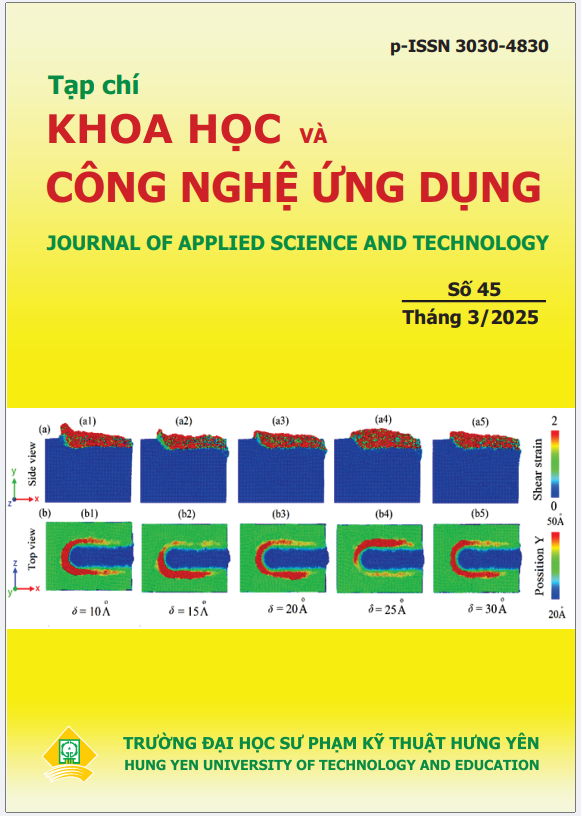INVESTIGATION OF SURFACE ROUGHNESS OF STAINLESS STEEL- INOX 304 DURING ELECTROPOLISHING WITH ADDITIVES
Abstract
The electropolishing method has been widely applied to enhance the surface smoothness of stainless steel materials. However, safety concerns during the polishing process are of particular importance, as the electrolytes used typically contain high concentrations of strong acids, such as sulfuric acid (H₂SO₄) at 35 wt.% and phosphoric acid (H₃PO₄) at 50 wt.%. Therefore, this study focuses on determining the optimal composition of electrolyte components and appropriate polishing conditions to improve surface treatment efficiency while ensuring workplace safety. The results identified a suitable electrolyte solution and an optimal polishing temperature range of 30–50°C for stainless steel 304. Specifically, when adding the chromium oxide (CrO₃) additive, despite reducing the H₂SO₄ concentration to approximately 20 wt.%, the surface roughness achieved was significantly low (Ra = 0.075 µm). Furthermore, by incorporating the Glycezyl additive, even though the H₂SO₄ and H₃PO₄ concentrations were simultaneously reduced to 24. wt% and 18. wt%, respectively—considerably lower than those used in previous studies—the achieved surface roughness remained comparable, with Ra reaching 0.118 µm.
References
Yang, G., Wang, B., Tawfiq, K., Wei, H., Zhou, S., & Chen, G., Electropolishing of surfaces: theory and applications. Surface Engineering, 2017, 33(2), pp. 149-166.
Andrade, L. S., Xavier, S. C., Rocha-Filho, R. C., Bocchi, N., & Biaggio, S. R., Electropolishing of AISI-304 stainless steel using an oxidizing solution originally used for electrochemical coloration. Electrochimica Acta, 2005, 50(13), pp. 2623-2627.
Charazińska, S., Sikora, A., Malczewska, B., & Lochyński, P., Reconstruction of the Passive Layer of AISI 304 and 316 Steel After Scratching. Materials, 2024, 17(24), 6238.
Zohoor, M., Jalili, S., Alipour, A., & Mosallanejad, R., Effect of electrolyte type on electrochemical machining of 304 steel. International Journal of Applied Engineering Research, 2016, 12(III), 20.
Lin, C. C., Hu, C. C., & Lee, T. C., Electropolishing of 304 stainless steel: Interactive effects of glycerol content, bath temperature, and current density on surface roughness and morphology. Surface and Coatings Technology, 2009, 204(4), pp. 448-454.
Oravcová, M., Palček, P., Zatkalíková, V., Tański, T., & Król, M., Surface treatment and corrosion behaviour of austenitic stainless steel biomaterial. In IOP Conference Series: Materials Science and Engineering. IOP Publishing, 2017, Vol. 175, No. 1, p. 012009.
Lyczkowska-Widlak, E., Lochynski, P., Nawrat, G., & Chlebus, E., Comparison of electropolished 316L steel samples manufactured by SLM and traditional technology. Rapid Prototyping Journal, 2019, 25(3), pp. 566-580.
Lochynski, P., Kowalski, M., Szczygiel, B., & Kuczewski, K., Improvement of the stainless steel electropolishing process by organic additives. Polish Journal of Chemical Technology, 2016, 18(4), pp. 76-81.
Łyczkowska-Widłak, E., Lochyński, P., & Nawrat, G., Electrochemical polishing of austenitic stainless steels. Materials, 2020, 13(11), 2557.
Han, G., Lu, Z., Ru, X., Chen, J., Xiao, Q., & Tian, Y., Improving the oxidation resistance of 316L stainless steel in simulated pressurized water reactor primary water by electropolishing treatment. Journal of Nuclear Materials, 2015, 467, pp. 194-204.

